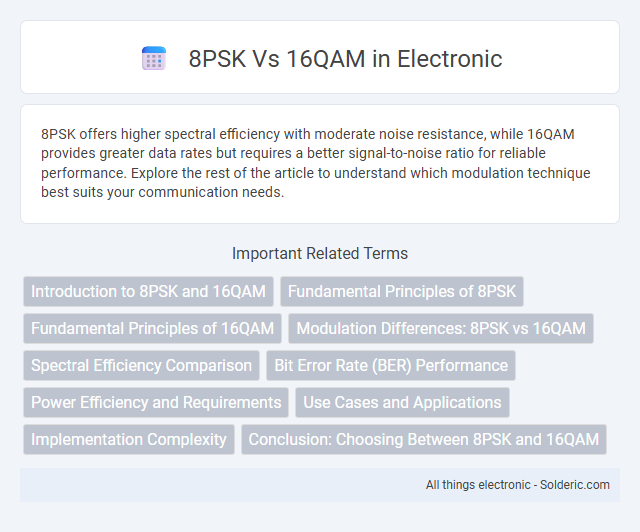8PSK offers higher spectral efficiency with moderate noise resistance, while 16QAM provides greater data rates but requires a better signal-to-noise ratio for reliable performance. Explore the rest of the article to understand which modulation technique best suits your communication needs.
Comparison Table
| Feature | 8PSK (8 Phase Shift Keying) | 16QAM (16 Quadrature Amplitude Modulation) |
|---|---|---|
| Modulation Type | Phase Modulation | Amplitude & Phase Modulation |
| Bits per Symbol | 3 bits | 4 bits |
| Spectrum Efficiency | Moderate | Higher |
| Signal Robustness | Better in noisy channels | Less robust, sensitive to noise |
| Complexity | Lower | Higher |
| Use Cases | Satellite, Digital TV | WiFi, LTE, Broadband |
| Bit Error Rate (BER) | Lower BER at low SNR | Higher BER, requires higher SNR |
| Power Efficiency | More power-efficient | Less power-efficient |
Introduction to 8PSK and 16QAM
8PSK (8 Phase Shift Keying) encodes data by shifting the phase of a carrier signal into one of eight distinct states, offering a balance between spectral efficiency and noise resilience. 16QAM (16 Quadrature Amplitude Modulation) combines amplitude and phase modulation across 16 constellation points, providing higher data rates but with increased susceptibility to noise and nonlinearities. Your choice between 8PSK and 16QAM depends on channel conditions and system requirements for data throughput and error performance.
Fundamental Principles of 8PSK
8PSK (8 Phase Shift Keying) modulates data by changing the phase of the carrier wave into eight distinct states, allowing it to encode three bits per symbol. This phase manipulation improves spectral efficiency compared to lower-order modulation schemes, but it requires a higher signal-to-noise ratio (SNR) for reliable detection. Understanding these fundamental principles helps you optimize your communication system for balancing bandwidth efficiency and error performance.
Fundamental Principles of 16QAM
16QAM (16 Quadrature Amplitude Modulation) combines amplitude and phase variations to encode four bits per symbol, enabling higher data rates compared to 8PSK's three bits per symbol phase-only modulation. This method transmits data by modulating both the in-phase (I) and quadrature (Q) components, resulting in 16 distinct constellation points arranged in a grid, optimizing bandwidth efficiency. The trade-off involves increased susceptibility to noise due to closer symbol spacing, demanding higher signal-to-noise ratios (SNR) for reliable communication.
Modulation Differences: 8PSK vs 16QAM
8PSK (8 Phase Shift Keying) modulates data by changing the phase of the carrier signal among eight distinct states, offering three bits per symbol and improved spectral efficiency compared to QPSK. In contrast, 16QAM (16 Quadrature Amplitude Modulation) combines both amplitude and phase variations, encoding four bits per symbol through sixteen unique constellation points, providing higher data rates but increased susceptibility to noise. The key modulation difference lies in 8PSK's phase-only variations versus 16QAM's combined amplitude-phase approach, impacting their resilience and performance in different channel conditions.
Spectral Efficiency Comparison
8PSK offers moderate spectral efficiency by encoding three bits per symbol, while 16QAM significantly enhances spectral efficiency by encoding four bits per symbol within the same bandwidth. The increased bit capacity of 16QAM leads to higher data rates, making it preferable in bandwidth-constrained systems. However, 16QAM requires better signal-to-noise ratio conditions to maintain reliable communication compared to 8PSK.
Bit Error Rate (BER) Performance
8PSK exhibits a higher Bit Error Rate (BER) compared to 16QAM at similar signal-to-noise ratios due to its lower Euclidean distance between constellation points. 16QAM benefits from more distinct symbol separation, resulting in improved BER performance in additive white Gaussian noise (AWGN) channels. However, 8PSK provides spectral efficiency advantages when channel conditions are favorable, despite its comparatively higher BER.
Power Efficiency and Requirements
8PSK (8 Phase Shift Keying) exhibits higher power efficiency compared to 16QAM (16 Quadrature Amplitude Modulation) due to its constant envelope signal, which allows for more efficient amplification and lower error rates at a given signal-to-noise ratio (SNR). In contrast, 16QAM, while offering higher spectral efficiency by transmitting 4 bits per symbol, requires a significantly higher SNR to maintain the same bit error rate (BER), resulting in increased power requirements and more complex linear amplification. Consequently, 8PSK is often preferred in scenarios with strict power constraints, whereas 16QAM is suitable for systems prioritizing bandwidth efficiency and capable of supporting higher power consumption.
Use Cases and Applications
8PSK modulation is commonly used in satellite communication and mobile networks where bandwidth efficiency and moderate data rates are required, offering robustness against noise and phase errors. 16QAM provides higher data rates suitable for broadband internet, digital TV, and LTE systems, but requires better signal quality due to its sensitivity to noise and interference. Both modulation schemes balance bandwidth and power efficiency based on application demands, with 8PSK favored for stable, low-SNR environments and 16QAM preferred in high-SNR scenarios demanding greater throughput.
Implementation Complexity
8PSK (8 Phase Shift Keying) features lower implementation complexity due to simpler modulation and demodulation processes compared to 16QAM (16 Quadrature Amplitude Modulation), which requires more sophisticated amplitude and phase detection. The signal constellation of 8PSK, consisting only of phase variations, reduces the demands on analog-to-digital converters and error correction algorithms. In contrast, 16QAM's combined amplitude and phase modulation increases digital signal processing requirements and hardware complexity for accurate symbol recovery under noisy channel conditions.
Conclusion: Choosing Between 8PSK and 16QAM
8PSK offers better noise resilience and lower error rates, making it ideal for environments with weaker signal strength or higher interference. 16QAM provides higher spectral efficiency and data throughput, suitable for applications requiring faster data transmission in stable, high-SNR conditions. Selecting between 8PSK and 16QAM depends on the trade-off between data rate demands and channel quality, emphasizing the balance between robustness and bandwidth efficiency.
8PSK vs 16QAM Infographic

 solderic.com
solderic.com